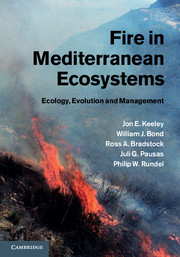5 - Fire in California
from Section II - Regional patterns
Published online by Cambridge University Press: 05 January 2012
Summary
On the west coast of North America lies the state of California, USA (Fig. 5.1), the bulk of which is dominated by a mediterranean-type climate (MTC). Elevations range from sea level to over 4000 m. Mountain ranges are largely oriented north to south with a major valley between the coastal ranges and the interior Sierra Nevada range. In the rain shadow east of the interior mountain ranges the climate is more continental with much colder winters and increasing proportion of summer precipitation eastward. This easternmost part of the state has steppe climates in the northern portion and desert climates in the south. In Arizona and a few other parts of southwestern USA and northeastern Mexico are disjunct patches of sclerophyllous-leaved vegetation that closely resembles California MTC vegetation. These include evergreen shrublands, broadleaf woodlands and conifer forests and represent mediterranean-type vegetation (MTV) under non-MTCs. Further east at similar latitudes but under different climates are sclerophyll forests with many similarities to MTC conifer forests.
The California Floristic Province (Raven & Axelrod 1978) essentially circumscribes the MTC vegetation of North America and extends across the latitudinal range of the state. On the western slopes of the major mountain ranges is a rich diversity of vegetation types that change along the elevational gradient. Ascending the coastal mountains the main vegetation types sort out along gradients of decreasing aridity in the following order: grasslands, semi-deciduous woody sage scrub, evergreen chaparral shrublands, oak woodlands and conifer forests. A similar pattern is evident on the west side of the interior Sierra Nevada except for the absence of sage scrub. These vegetation types exhibit marked differences in fire regime and tolerance to disturbance tied to the different patterns of fuel structure resulting from changes in dominant growth forms along the elevational gradient. Along this gradient there is an interaction between fires and aridity such that lower fire frequency is required to displace shrubland associations with grasslands and other herbaceous vegetation on xeric than on mesic landscapes (Keeley 2002b). Consequently there are complex local mosaics due to differences in aspect and fire history (see Fig. 1.6c).
- Type
- Chapter
- Information
- Fire in Mediterranean EcosystemsEcology, Evolution and Management, pp. 113 - 149Publisher: Cambridge University PressPrint publication year: 2011



